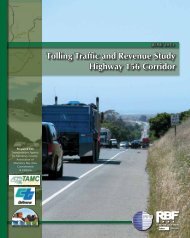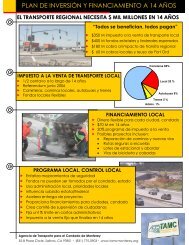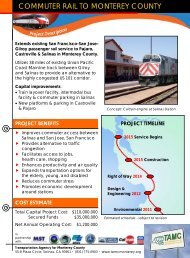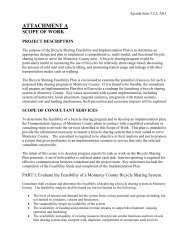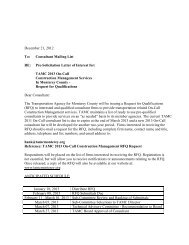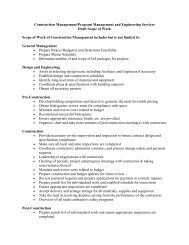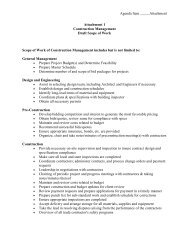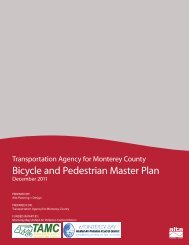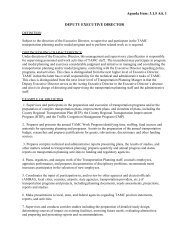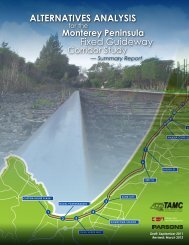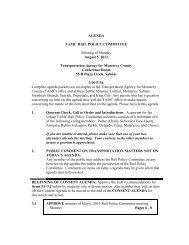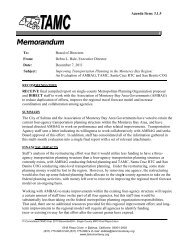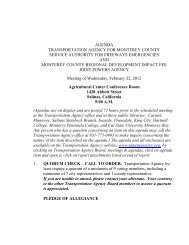Commuter Rail Extension Alternatives Analysis - Transportation ...
Commuter Rail Extension Alternatives Analysis - Transportation ...
Commuter Rail Extension Alternatives Analysis - Transportation ...
Create successful ePaper yourself
Turn your PDF publications into a flip-book with our unique Google optimized e-Paper software.
CALTRAIN EXTENSION TO MONTEREY COUNTYALTERNATIVES ANALYSISbound trains) are forecast at 1,000 riders per day, based on Year 2000 commuting patterns. Thesecommuting patterns appear to hold true as of 2005/2006, and are assumed for 2010 opening yearconditions. Year 2030 boardings at Monterey County stations are forecast as 2,000 riders per day. Inthe afternoon, an equal number of riders would board at San Francisco Bay Area stations (PMsouthbound trains) and ride south to Monterey County.Of this ridership, 90 percent are forecast to ride to stations within Santa Clara County. Seven percentof the riders are forecast to travel to San Mateo County destinations and three percent to SanFrancisco.Vehicle RequirementsThe Caltrain <strong>Extension</strong> Alternative assumesthat existing JPB trainsets operatingto/from Gilroy would be utilized.No additional trainsets would berequired. Additional wear and tear ontrainset locomotives and rolling stockwill be addressed through the fullyallocated cost formula. Vehicle replacementswill be addressed by acapital recovery (mileage based) fee tobe determined through negotiationswith JPB.Trainsets operating to/from Gilroy haveresidual, unused capacity. As of theFebruary 2006 boarding count, nomore than 470 seats were occupied onthe three trains serving Gilroy south ofthe Tamien station; and approximately1,480 seats were vacant (for theportion of the train trip between SanJose Tamien and Gilroy). System-wide,the maximum load point for Caltrainhas historically been at or near theMillbrae station in San Mateo County,well north of most Monterey Countyresident forecast ridership.Actual Monterey County Caltrainridership patterns would be determinedthrough rider surveys and analysis ofCaltrain ticket (zone 8) sales. Thisdata, in conjunction with passengerload checks on trains serving MontereyCounty, would be used to accessMonterey County-generated rollingstock requirements.Caltrain Vehicle Technology OptionsThe issue of rolling stock availability and technology is complex, andremains under negotiation between JPB and TAMC. Project 2025 setsforth three rolling stock options.Under its Current Program—Diesel Locomotives scenario, JPB wouldcontinue to operate its 96 train weekday schedule, with slightly longertrain consists (up to six cars per train) where required to meet capacityrequirements. JPB currently operates 20 sets of rolling stock with oneset aside as a preventive maintenance spare. The current fleet totals110 cab/trailer cars and 29 diesel powered locomotives. These wouldbe replaced as lifecycle and maintenance requirements dictate.Project 2025 notes there is an immediate need to acquire eightadditional cars in the near-term to bolster spare ratios and provideadditional capacity in the form of longer train sets on those trainswhich are operating nearest to capacity. Without additional capacity,JPB has stated that they will be unable to extend service to Salinas,due to their spare vehicle shortfall, and preventive maintenancecycles.Under Alternative A: Electric Locomotives, JPB would replace themajority of its diesel locomotives with electric powered locomotives.JPB would also replace its gallery-style trailers and cab cars (73purchased in 1985 and 20 purchased in 2000) with bi-level, low-floorcars. The fleet would be expanded to provide additional service asdemand warrants. Diesel rolling stock would continue to operate onthe Gilroy extension, and could run “under the wire” as far north as theFourth and Townsend station in San Francisco (the line’s currentnorthern terminus).Under Alternative B: Rapid Transit Non-compliant EMUs, JPB wouldreplace its entire fleet of locomotives and passenger coaches withrapid transit vehicles, specifically electric multiple units (EMUs). AnFRA-compliant EMU to Caltrain specification does not yet exist;therefore, JPB assumes operation of non-compliant EMUs forALternative B operations. To allow for operation of mixed compliantand non-compliant fleets, a FRA waiver would be required. Givensuch a waiver, JPB could transition from diesel locomotive hauledequipment to EMUs over time, and could operate Dumbarton andGilroy/Salinas extension services, as well as freight service, “underthe wire.”parsons CHAPTER 3: DETAILED DEFINITION OF ALTERNATIVES 63



